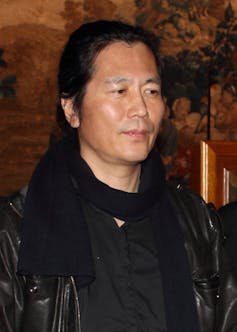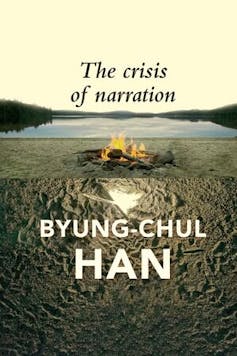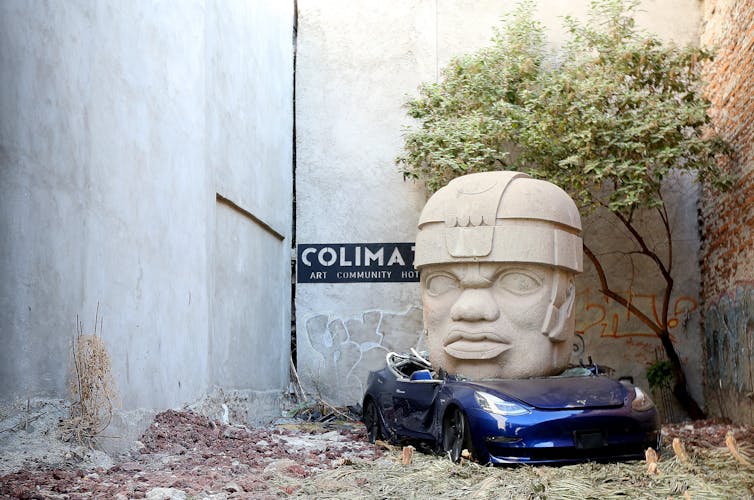Byung-chul Han is an enigmatic philosopher and author of Burnout and Psychopolitics: Neoliberalism and the New Technologies of Power. In his latest book, The Crisis of Narration, he argues that “despite the current hype about narrative, we live in a post-narrative era.”
“The Crisis of Narration” – Byung-chul Han, translated by Daniel Steuer (Polity)
Han suggests that the narrative is under threat. It is being consumed and reshaped by capitalism and neoliberalism. The environment where stories once provided meaning and stability is now filled with information. This is a serialized, non-narrative form of communication.

ActuaLitte, via Wikimedia Commons, CC BY-SA
According to Han, information provides stimulation rather than direction or meaning. The tendency to count, measure, and define information pervades the self and society. Its mission to eradicate uncertainty spans health, education, Netflix recommendations, human rights, and more. Han writes that this information does not provide understanding but a “deep forest” in which “we risk losing ourselves.”
What we lose in the noisy forest of information, Han suggests, is the space to “open up perspectives on a new order of things.” We become blind to “other forms of life” and “other perceptions and realities.”
He believes that the crisis in storytelling lies in the almost sublime dominance of information in our world. But what gives me hope is his clear observation in the book that we: Must talk. Narration in its authentic form is one of the most powerful things we can do, and will likely be the path to re-enchanting Han's “post-narrative” world.
story community
The Crisis of Narrative is a valuable confrontation with the question of what “narrative” actually is and what it does in the modern context.
Stories are such a fundamental way of understanding and organizing the world that we intuitively feel the meaning of words. But narrative is also a term that can be mobilized for corporate purposes. Sometimes it pretends to be apolitical, something merely for entertainment, and distinct from social and cultural relations.
We are exposed to stories that offer us ways to understand the world. It's used to package and sell everything from venture capital and beauty brands to literary festivals and washing machines and socks. At the same time, the word story applies to our richest creative endeavors. It extends to ancient oral storytelling traditions that have been maintained across time and space.
These various “stories” are not the same. Han argues that authentic stories imprint meaning on the world in “an intimate network of relationships” where “nothing is isolated” and “everything continues to have meaning.”
His provocations suggest that the narrative, typically used to “validate the interests of corporate entities and demand our obedience” by exploiting individualist ideology and appealing to ideas of self-expression, actually That's not a story at all. Rather, they are what he calls “story selling.”
Han makes a multifaceted case for the distinct ways in which “narrative” is distinguished from “storyselling.” But the example that resonates most with me is the emphasis on the ability of stories to create community. Narrative communities, he suggests, are formed only when narration “feeds on experience” and that the role of the “attentive listener” is as important as that of the narrator.
Narrative communities have an intimacy and empathy that depends on a willingness to experience difference. They tolerate uncertainty, from which new ideas emerge in dialogue with past experiences.
Storyselling, unlike narration, seeks to eradicate uncertainty. Therefore, “it is not possible to design substantially different forms of life.” It fails to fulfill the important role of narration: imagining the future.
Read more: Tourists in our own reality: Susan Sontag's 50-year-old photo
disillusionment
In the chapter “Disenchantment of the World,'' Mr. Han bases his argument on Susan Sontag's essay “At the Same Time.'' He writes, “A story is a play between light and shadow, the visible and the invisible, the near and the distant.'' This capacity for uncertainty gives the world meaning and fascination.
Han interprets the zeitgeist of the story through the iconic works of Theodor Adorno, Jacques Lacan, and other European philosophers, with particular attention to the work of Walter Benjamin. He cites Benjamin when he suggests that the space for uncertainty and dialogue in a narrative community is driven out by a stimulus of information, which he refers to as “the rustling of leaves.” I'm here.

Quoting Benjamin, Han writes that an enchanted world is one in which we have invested “our capacity for self-reflection.” Another way to put this is that stories give space for others to express what we don't quite understand, without being obligated to explain itself for our consumption. is.
An observable symptom of the “information society,” Han points out, is transparency, which destroys the tension of authentic stories. Stories operate in a space of possibility between certainty and uncertainty. In contrast, the information society becomes disillusioned by dissolving the world into data. When the world is experienced through information, the generative uncertainty and “distance and breadth” necessary for narrative communities are lost.
Han writes, “The gaze of reality is the gaze that others look at us.” He blames smartphones for disillusioning the world because they shield us from the gaze of reality. Their touchscreens rob the world of its otherness, rendering it inapplicable to us. Instead, the world of objects becomes expendable. That would be information.
Read more: Walter Benjamin's Illumination: The astonishing and visionary work of an intellectual truth seeker
forest and trees
There are several aspects of Han's argument that require further consideration. One is the persistent appeal to society's “us” and “us.”
For Han, the “phono sapiens,'' a fusion of humans and telephones, is a symbol of the “information society.'' But to me, this oversimplifies the relationship between narration, story-selling, environment, and technology. Although Mr. Han seems to be addressing everyone with a smartphone, he is not addressing the global networks of mining operations, factories, exchanges, exploitation, and extraction that make such ends possible.

Leah Newhouse/Pexels
In Han's alienated society, “we” cannot exist unless we address the stratification of power. We need to think about who is the beneficiary of the information forest, and who is trapped in the information forest. Although Han's engagement with 20th-century European philosophy is thoughtful and generative, I noted the absence of queer, Indigenous, and diasporic writers who have recently considered some of the issues he raises.
For me, projects that seek to address the heritage of storytelling communities and questions of their preservation require recognition of indigenous knowledge practices. While many Indigenous storytelling communities navigate the “information society” with the aim of sustaining and sustaining some kind of dialogue between past, present, and future, Han said “we” claims to be losing.
re-enchantment
The problem of narrative deprivation and dispersion is real. They show up in conversations with just about everyone I know. However, I am not convinced that we are “post-narrative” as Han claims at the beginning of the book.
But one of the joys of reading Han's work is that his arguments end with concepts that make counter-narratives possible, even if he doesn't clearly outline what a counter-narrative should look like. There are many.
“The Crisis of Narration” reflects on reality, accepts it, and welcomes it. I want the reader's “lingering impression''. After reading Han's book, I thought about the question of how the gaze of reality can be re-enchanted not by the absence of screens, but in spite of them.
Earlier this year in Mexico City, artist Chavis Marmol dropped a nine-ton replica of the giant head sculpture of the Olmec people, the first known Mesoamerican civilization, into a blue Tesla 3. The Olmec head landed a year after Tesla announced plans to build the car. A huge factory in northern Mexico.

Fernando de Dios/Getty Images
Marmor's Olmec head is impressive for its straight line of sight. Tesla and its owner Elon Musk represent an exploitative corporate oligarchy profiting from the narrative crisis and information forest addressed by Mr. Han.
However, this power is interestingly shown to be weak against the weight of the Olmec head narrative. To imagine an Olmec head crushing Tesla, Marmol needed to look back and listen to the story of an Olmec head. He needed to consider the stories they embodied in the light of his own experiences.
Marmor and the Olmec chiefs together create a community of stories. They ask us to listen with them. In the Marmor story, Tesla's story-selling is flimsy and unsustainable under the weight of indigenous stories about the land and its people.
Marmor tells this story in a single image. He tells Musk: “See what this awesome head can do to your goddamn car.”
In The Crisis of Narration, Han tells readers that the greatest threat to capitalist story-selling is the formation of authentic narrative communities. I would add that the formation of these resistant narrative communities is necessarily pluralistic. They form organically across online and physical spaces.
Modern storytelling communities can talk and listen, even with smartphones in hand.

